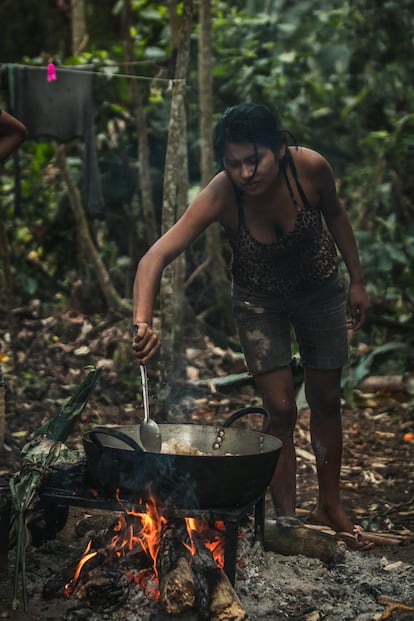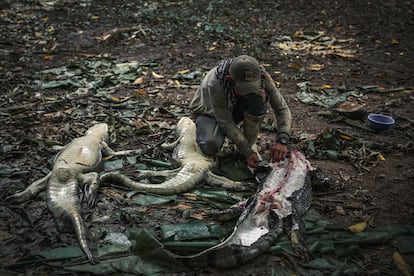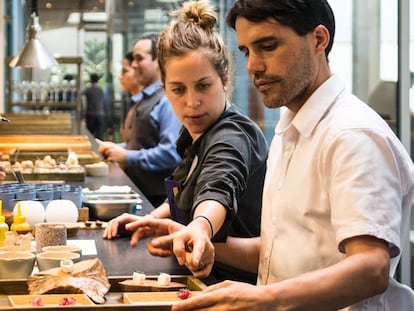Marsia Taha, the chef who made Bolivia eat alligators
For the Tacana indigenous people, the legal, sustainable and controlled use of the yacare caiman has become a primary activity for utilizing natural resources

At the intersection between the Andes and the Amazon, the jungle territory that encompasses the Great Madidi-Tambopata Landscape begins. That’s the natural space from which caiman alligator meat comes, which chef Marsia Taha and her entire team serve at Gustu, which was named Best Restaurant in Bolivia in 2022. “We have been working with this meat since 2015, when the Wildlife Conservation Society (WCS) and the Tacana indigenous community offered it to us,” she explains from La Paz. But it wasn’t until 2018 when they traveled there to understand how entire families worked and lived from their sustainable production: “We didn’t go before because entering these communities is not easy, you need to develop trust. They are also remote places and access is difficult, but since we were already working with their meat and were going along with our partners, they extended a special welcome to us.”
Each year, through its Sabores Silvestres [Wild Flavors] project and foundation, the Gustu team makes several trips to Bolivian territory to learn more about the culture and native products. The foundation seeks to “boost the conservation of biodiversity, preserve food heritage and promote Bolivian gastronomic culture,” Marsia explains. “Between 60 and 70% of Bolivia is Amazonian. We have more than 37 indigenous communities, so we are focused on traveling there.” Based on the foundation’s research of its native country, this cuisine serves two purposes: on the one hand, it shows the restaurant’s clientele Bolivia’s flavors, culture and biodiversity; and, on the other hand, it helps raise awareness of the raw materials they find on their trips and then teach about and revalue them. In this way, they allow Bolivian society and other cooks to learn more about these foods and facilitate their accessibility. That’s what they did with the yacare caiman, which arrived at the restaurant through this collaboration and has become one of the menu’s flagship raw materials.

In much of the Amazon, consumption of this reptile is not unusual among the communities. “Although it is not the most widely consumed meat, it has always been used locally in different sectors of communities and in some cities,” says Gustavo Álvarez, the biologist in charge of Wildlife Management Projects for the Wildlife Conservation Society. This NGO, which specializes in the conservation of natural spaces through joint work with indigenous peoples, has been working with the Indigenous Council of the Tacana People (CIPTA), the Ministry of Environment and Water (MMAyA) and the National Agricultural Health and Food Safety Service of Bolivia (SENASAG) to promote the National Program for the Conservation and Sustainable Use of the Yacare Caiman, a project that allows the sustainable use of caiman meat through a management plan and the study of its population.
“The caimans were illegally hunted by people from outside the communities before; now the Tacana community controls the [yacare caiman] population,” explains Álvarez. Between the 1960s and 1980s, the indiscriminate and illegal hunting of wild and endangered animals took a toll on the Bolivian Amazon. Later, European demand for their skins became a legal form of income for these communities. Large European luxury corporations received hides directly from this area to manufacture handbags and wallets. “They knew that there was an economic benefit to selling the skin, but they discarded the meat, so we supported them in learning how to manage their resources sustainably,” he says. Thinking about the possibility of selling it and taking advantage of the entire animal, they trained workers and created a mobile space in the middle of the jungle to work in situ, complying with all public health requirements and without breaking the cold chain. Hunting is done only once a year on new-moon nights between October and November after the breeding season, and the process takes a series of parameters into account: the yacare caiman populations must have 25% of adult males measuring more than 1.80 meters (6 feet) in length, and only a quarter of them will be slaughtered.

“In the jungle, the communities cook it as if it were pork rinds; they overcook it for health reasons and make it with the same skin so that it does not shrink down. They also use the same preparation techniques they use for fish like the tacuara method (it is cooked inside bamboo trunks), grilled or cooked over hot coal in palm leaves, or in a sudado (a soup that includes tomatoes, onion, garlic, peppers, cilantro, fruit rinds and small pieces of caiman meat),” says the chef. When they started working with the yacare caiman meat at Gustu, they tested it extensively, “but we realized that raw was the best way to take advantage of its flavor, texture and aroma. We smoke it or make quick cured products to eat the [meat] in a tiradito [a raw preparation] or a ceviche, but we never overcook it in the traditional way.”
Although yacare caiman meat was already consumed in certain areas of the country, when the restaurant began to serve it, people were reluctant to order it unless it was on the tasting menu. “As time has gone by, the public has gotten used to it, and it has become a commonly consumed meat. Its increased use in the catering world, along with obtaining a seal that certifies the sale of their meat, allowed the Tacanas to start distributing it to the Bolivian supermarket chain Hipermaxi in the cities of Santa Cruz, La Paz and Cochabamba in 2018,” the chef says. In addition, at home “families have started to treat it as if it were a fish because it can be marinated, fried, grilled, prepared in ceviche or pickled. The meat is a hybrid between fish and boiled chicken.” And she emphasizes: “In the restaurant, we have a certificate that ensures that the caiman meat comes from a legal and sustainable [source]. This is essential because when people do not have the option of doing what they have always done to bring food and money home, they exploit non-renewable resources like gold mining’s use of mercury, which also contaminates the Amazonian rivers and destroys their biodiversity.” With the NGO’s help, the restaurant is trying to combat such practices through the legal and controlled exploitation of the reptile. “We seek to provide work alternatives through contact with restaurants and supermarkets so that [indigenous communities] can earn an income and have market opportunities without engaging in illegal activities,” Gustavo concludes.
Sign up for our weekly newsletter to get more English-language news coverage from EL PAÍS USA Edition
Tu suscripción se está usando en otro dispositivo
¿Quieres añadir otro usuario a tu suscripción?
Si continúas leyendo en este dispositivo, no se podrá leer en el otro.
FlechaTu suscripción se está usando en otro dispositivo y solo puedes acceder a EL PAÍS desde un dispositivo a la vez.
Si quieres compartir tu cuenta, cambia tu suscripción a la modalidad Premium, así podrás añadir otro usuario. Cada uno accederá con su propia cuenta de email, lo que os permitirá personalizar vuestra experiencia en EL PAÍS.
¿Tienes una suscripción de empresa? Accede aquí para contratar más cuentas.
En el caso de no saber quién está usando tu cuenta, te recomendamos cambiar tu contraseña aquí.
Si decides continuar compartiendo tu cuenta, este mensaje se mostrará en tu dispositivo y en el de la otra persona que está usando tu cuenta de forma indefinida, afectando a tu experiencia de lectura. Puedes consultar aquí los términos y condiciones de la suscripción digital.
More information
Archived In
Últimas noticias
Most viewed
- Reinhard Genzel, Nobel laureate in physics: ‘One-minute videos will never give you the truth’
- Oona Chaplin: ‘I told James Cameron that I was living in a treehouse and starting a permaculture project with a friend’
- Pablo Escobar’s hippos: A serious environmental problem, 40 years on
- Charles Dubouloz, mountaineering star, retires at 36 with a farewell tour inspired by Walter Bonatti
- Why we lost the habit of sleeping in two segments and how that changed our sense of time










































